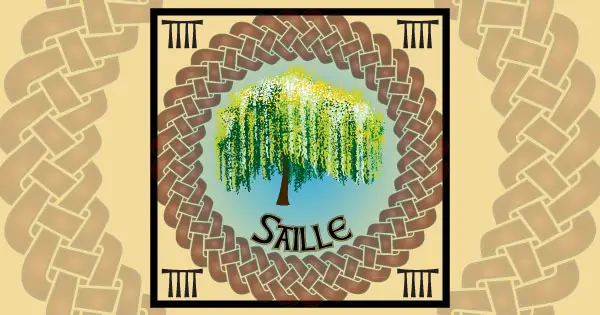The Willow was a sacred tree to the Celts both for the wide range of materials it provided and for its unique beauty and spiritual presence.
It appears throughout the mythology of many cultures. In the Druid stories, the universe and all mankind was hatched from two scarlet eggs hidden within the willow tree. One egg formed the sun and the other the Earth.
In the seasonal festival of Beltane this story was re-enacted using painted eggs, a practice later adopted by the Christians and named Easter.
Tabernacles
In Hebrew culture the willow is associated with the Feast of the Tabernacles, where shelters were built using the branches of the willow, a tradition still followed in Jerusalem today.
In Greek mythology Willow was sacred to the Goddesses of the underworld, Persephone, Hecate, Circe and Hera. This was also the case in Celtic mythology where the willow was connected to the death goddesses representing dark, aspects of the psyche that require great understanding and challenge wisdom and strength.
In relation to these myths, the willow flower remedy is said to alleviate bitterness and resentment and benefit those who often blame others for their misfortunes. Willow leaves were often worn as charms to protect against jealousy and the wood of the willow inside and outside of a dwelling was said to protect against evil.
The Willow Craft
Willow had many practical uses in old Ireland, Britain and throughout the World, as well as spiritual ones.
It was used in the walls of houses as part of wattle and daub, made into fence posts and barrels and woven into wicker baskets, furniture, beehives, fencing and lobster pots to name just a few of its many uses.
The word ‘wic’ (from wicker) in Old English literally meant ‘to bend’.
When Christianity spread throughout Britain and Ireland the Christians formed large urban centres and took to referring to those in rural environments, who practiced the old country ways, as ‘wicca’ (pronounced wik-chah), for men, ‘wicce’ women, or ‘wiccan’ plural, literally those who bend and manipulate.
Perhaps because creating objects from willow branches(wicker) was such a common everyday job for the country folk, Wiccan came to be a derogatory term used to represent all those men and women who followed the old ways and crafts.
Wicker came to be associated with witchcraft
Saille, Seille, S – Willow is the fourth letter of the ogham alphabet ‘Saille’ and the fifth month of the Celtic tree calendar. A symbol That Spring has come, it is the first tree to flower in Spring, so loved by bees, and the last tree to lose its vibrant colour in Autumn.
Through the years, as cultures became more separated, this evolved into the idea of witchcraft. To bend and manipulate became related to magic and spells and the Christians didn’t much like the idea of the folk practicing these activities.
Medicinally, willow bark has been used as a remedy for soothing pain since Ancient Greece. The bark of the willow contains salicin which, when oxidised in the human body, becomes salicylic acid, later to be turned into what we know as aspirin.
Willow was also used to treat rashes, dandruff, bleeding gums and mouth inflammations. It was also used to prevent fever and dyspepsia.
